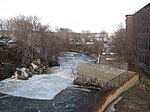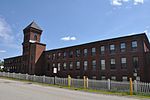Robie's Country Store

Robie's Country Store is a historic store at 9 Riverside Street in Hooksett, New Hampshire, United States. As a business, the general store was in continuous operation between 1822 and 1997, the last 110 years under the ownership of the Robie family from 1887, from whence it gets its name. The current building, constructed in 1906 following a fire, is a rare regional example of a store with a "boomtown" facade. It has been a political stop for presidential candidates since the early 1950s. Robie's Country Store was added to the National Register of Historic Places in 2000, and the New Hampshire State Register of Historic Places in 2002. It is now owned by a non-profit organization, with the store operated under lease.
Excerpt from the Wikipedia article Robie's Country Store (License: CC BY-SA 3.0, Authors, Images).Robie's Country Store
Main Street,
Geographical coordinates (GPS) Address Nearby Places Show on map
Geographical coordinates (GPS)
| Latitude | Longitude |
|---|---|
| N 43.097777777778 ° | E -71.466388888889 ° |
Address
Main Street
Main Street
03106
New Hampshire, United States
Open on Google Maps









